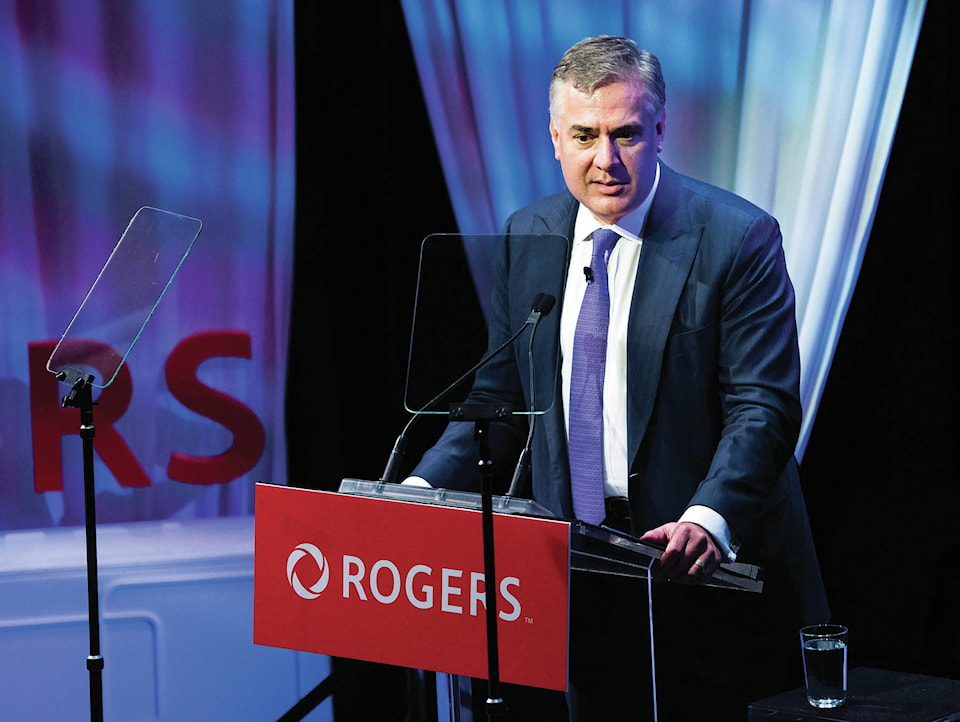TORONTO — The chief executive of Rogers Communications Inc. said Tuesday that a major change in wireless billing strategy is surpassing internal expectations, although overall subscriber additions in the second quarter missed analyst estimates.
The Toronto-based wireless, internet, cable and media company began selling wireless plans that don’t charge overage fees on June 13, a move since followed by Telus and Bell, which own Canada’s other national mobile phone services.
Overage fees contribute to the company’s wireless service revenue, but Rogers officials said they expect better economics in the medium and longer term to offset a moderation in revenue growth in the short term.
“While it is still early days, the response has been overwhelmingly positive,” Rogers CEO Joe Natale told analysts Tuesday on a second-quarter conference call.
Net additions to Rogers post-paid wireless services were down sharply from the same period of 2018. The company added 77,000 postpaid subscribers, compared with 122,000 a year earlier, and below a consensus estimate of 89,000.
By comparison, Freedom Mobile — which has had no-overage plans for more than a year — added 61,000 postpaid customers in its March-May quarter from a smaller base in Ontario, Alberta and British Columbia.
Natale focused more on the 365,000 subscribers who took up the new Rogers no-overage plans in six weeks, two-thirds of them choosing higher-priced monthly plans than they had previously.
Rogers had expected a majority to opt for lower-priced plans than they had, he said.
“And so we were quite pleasantly surprised to see the inverse happening,” Natale said.
Overall, analysts said the Rogers wireless business had a soft quarter — although opinions varied about whether its subscriber additions were disappointing or better than anticipated given that a general slowdown has been expected.
Analyst Drew McReynolds of RBC Dominion Securities wrote in a note to clients Tuesday that postpaid net additions at Rogers were better than RBC’s estimate of 67,000. By contrast, Aravinda Galappatthige of Canaccord Genuity said the 77,000 was short of his estimate of 95,000 and the consensus estimate of 89,000 net postpaid additions.
But Galappatthige also noted that the wireless division’s EBITDA (earnings before taxes and other items) was “robust” at $1.13 billion and “nicely above” his estimate of $1.119 billion and consensus of $1.120 billion.
Rogers is the first of Canada’s national wireless companies to report its second-quarter results and provide initial feedback from their adoption of no-overage plans since mid-June.
The Rogers financial report missed analyst estimates in terms of overall adjusted earnings per share and overall revenue.
Analysts had estimated $1.17 per share of adjusted earnings with $3.87 billion of revenue, according to the financial markets data firm Refinitiv.
The company’s revenue for the three months totalled $3.78 billion, up one per cent from $3.76 billion a year earlier.
Overall revenue from wireless, including services and devices, was $2.24 billion — up one per cent from last year. Revenue from the cable division was up one per cent to $997 million, with internet services as the major driver.
Revenue from the Rogers media division was down three per cent to $591 million, following the sale of its consumer magazines in April and lower revenue from the Toronto Blue Jays baseball team.
After adjustments, the diluted profit was equal to $1.16 per share.
The company’s second-quarter profit was $591 million, up 10 per cent from $538 million in the second quarter of 2018.
Rogers and Telus have also recently introduced new financing options that allow customers to spread the cost of new devices over several years. Bell hasn’t announced a device financing plan.
Last week, the Canadian Radio-television and Telecommunications Commission said it would investigate the deals to determine if they comply with an industry code of conduct that limits mandatory contract terms.
The wireless code requires carriers to limit service contracts to 24 months or less in length and there have been questions about whether device financing plans over a longer term would be acceptable to the regulator.
